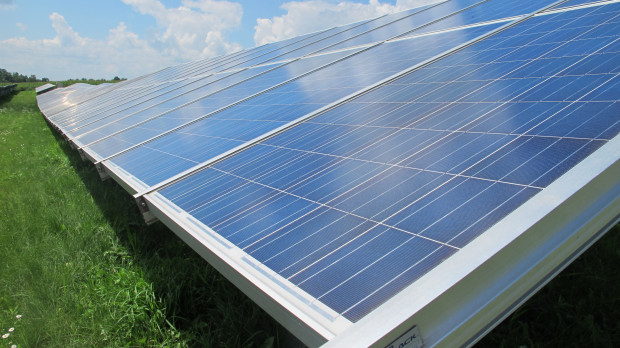Q&A: Law change expected to boost Pennsylvania’s solar industry
-
Marie Cusick

Marie Cusick / StateImpact Pennsylvania
The change in state law is expected to bring a boost to Pennsylvania’s solar industry.
A recent change to Pennsylvania law is expected to give a boost to the state’s solar industry.
On Oct. 30, Governor Tom Wolf signed a bill that will provide more protection for home-grown projects and prevent out-of-state solar power from affecting Pennsylvania’s marketplace for alternative energy.
StateImpact Pennsylvania discussed the significance of the change with Christina Simeone, Director of Policy and External Affairs for the Kleinman Center for Energy Policy at the University of Pennsylvania.
Note: this interview has been edited for length and clarity
Q: There was some good news recently for the solar industry in Pennsylvania, right?
A: Very good news for the solar industry in Pennsylvania. A change in law was made that will incentivize more solar being built in Pennsylvania. People are basically saying this is now “closing Pennsylvania’s borders.” I’ll explain that, but to understand what happened recently, you have to look at the past.
In 2004, Pennsylvania established a law that a certain amount of electricity sold by utilities to consumers to be supplied by renewable energy.
Q: That’s the Alternative Energy Portfolio Standard.
A: Yes—that law required that by 2021, 18 percent of the electricity sold to consumers in Pennsylvania be supplied by alternative and renewable sources. Of that 18 percent, a half a percent would have to come from solar.
But the way the law was written, even though Pennsylvania ratepayers were paying for this renewable energy to be built, it didn’t necessarily have to be built within Pennsylvania. It could be built anywhere within the broader 13-state (plus DC) electricity grid, called PJM Interconnection. A lot of renewable energy got built in Pennsylvania and outside of Pennsylvania. Those projects generated credits that could be submitted for compliance with Pennsylvania’s law.
Q: Those are called Solar Renewable Energy Credits.
A: Yes, Renewable Energy Credits (RECs), or Solar Renewable Energy Credits (SRECs). The law was passed in 2004, but it turned out the amount of solar built grew much faster than the law anticipated. Some of that was because of the Recovery Act, some of it was the [Pennsylvania] Alternative Energy Investment Act of 2008.
Also, the cost of solar came down tremendously. What ended up happening was Pennsylvania had much more solar than initially expected. So, you had a high supply of solar, but the law only demanded a certain amount, and that dynamic led to the price of the SRECs dropping.*
A: So before this recent change–before the borders were closed–you could get credit for solar power produced outside of Pennsylvania.
Right. The oversupply problem has been lingering for many years. We just haven’t been able to dig out of the hole, because other states just keep adding solar before we can, because they may have more attractive incentives.
Q: Who benefits most now from the borders being closed?
A: I think it’s a benefit for Pennsylvanians, because now Pennsylvania ratepayer monies will go into building solar within Pennsylvania. Eventually as more solar comes online, the price of the SREC will start to go up.
Several years ago, we were seeing tremendous solar growth and a big uptick in solar jobs. We missed an opportunity to continue that growth by not realigning our law to where the market was. So I think this [change in the law] is an important step forward.
*For example, a Pennsylvania SREC sells for about $5, while neighboring state New Jersey sells for $193.
















